Ancient city of Bishapur
Printed From: History Community ~ All Empires
Category: General History
Forum Name: Historical Pictures Gallery
Forum Discription: Post and discuss images of historical places, arts and maps...
URL: http://www.allempires.com/forum/forum_posts.asp?TID=10342
Printed Date: 27-Apr-2024 at 13:06
Software Version: Web Wiz Forums 9.56a - http://www.webwizforums.com
Topic: Ancient city of Bishapur
Posted By: Alborz
Subject: Ancient city of Bishapur
Date Posted: 26-Mar-2006 at 21:07
|
Bishapur - The city
http://www.livius.org - www.livius.org
http://www.livius.org/a/iran/bishapur/bishapur_aerial.jpg"> |
The city of http://www.livius.org/a/iran/bishapur/bishapur.html - Bishapur , seen from the air. It was built by Roman soldiers who had been captured after the defeat of the Roman emperor http://www.livius.org/va-vh/valerian/valerian.html - Valerian in 260. Perhaps, they belonged to the http://www.livius.org/le-lh/legio/vi_ferrata.html - Sixth legion Ferrata , because this unit disappears from our sources after Valerian's defeat. Many aspects of Bishapur's architecture look Roman and do not belong to Iranian building traditions. An example is what specialists call the "Hippodamian street plan", which means that the city looks like a gridiron. |
Photo http://www.iranian.com/bahrami.html - Mahin Bahrami ( http://www.livius.org/mail2.html - ©* ) |
http://www.livius.org/a/iran/bishapur/bishapur_wall.JPG"> |
The walls of the aquare city. The royal rock reliefs on the http://www.livius.org/a/iran/bishapur/bishapur.html - preceding pages are behind the big rock (again an interesting geological feature). The http://www.livius.org/sao-sd/sassanids/sassanid_kings.html - Sassanid fort is on the left side of this rock. The walls are well-preserved. The foundations of towers can be discerned; they are round, which made easier the use of catapults. Once, the walls were 10 meters high and protected 50,000-80,000 people. |
|
http://www.livius.org/a/iran/bishapur/bishapur_palace_1.jpg"> |
The palace with its cruciform throne hall. |
Photo http://www.iranian.com/bahrami.html - Mahin Bahrami ( http://www.livius.org/mail2.html - ©* ) |
 |
According to French archaeologists, there was a large dome (Ř20 meters) covering the entire area, but the walls appear to be not strong enough to support a heavy superstructure. Perhaps, the building consisted of four half vaults (iwans) and an open square. If so, it belongs to the same building type as the (medieval) "four walled mosque". |
( http://www.livius.org/mail2.html - ©!!! ) |
http://www.livius.org/a/iran/bishapur/bishapur_palace_2.JPG"> |
The interior of the palace, at sunset. Once, the sixty-four niches were decorated with statues. |
|
http://www.livius.org/a/iran/bishapur/bishapur_palace_3.JPG"> |
The remains of stucco in one of the niches. They are decorated with patterns from Greek art, like leaf scrolls. Traces of yellow, black, and red paint can still be seen. |
|
http://www.livius.org/a/iran/bishapur/bishapur_mosaic_louvre.jpg"> |
Mosaics were found in several rooms. This face (or is it a mask in Dionysiac style?) has a laurel wreath, a Roman symbol not known in Sassanid Persia. Probably, the makers of the mosaic were from Antioch, which was well-known for its mosaic makers and was captured by Shapur in 253 and 260. |
|
http://www.livius.org/a/iran/bishapur/bishapur_mosaic2_louvre.jpg"> |
This scene is more adapted to oriental tastes. The lady wears a transparent veil. Like the mosaic of the face, this lovely picture of a musician is not in Bishapur itself: both pieces of art are now in France, in the http://www.louvre.fr/ - Louvre in Paris. |
|
http://www.livius.org/a/iran/bishapur/bishapur_mosaic_tehran.JPG"> |
Another mosaic from Bishapur, showing a lady with flowers. She can be seen in the National Archaeological Museum in Tehran. |
|
http://www.livius.org/a/iran/bishapur/bishapur_palace_4.JPG"> |
One of the corridors of the palace. On the aerial photos, this is the room to the left of the throne hall. |
|
http://www.livius.org/a/iran/bishapur/bishapur_frieze1.jpg"> |
Beyond this corridor is another square room, that was decorated with reliefs and mosaics: the eastern Mosaic Hall. This relief of a charging horseman was found in this room, and is now in the little museum near the excavation. You can still see traces of paint. |
|
http://www.livius.org/a/iran/bishapur/bishapur_w_mosaic_hall.JPG"> |
The western Mosaic Hall. On the aerial photos, this is the room to the right of the throne hall. |
|
http://www.livius.org/a/iran/bishapur/bishapur_temple_anahita_1.jpg"> |
The temple of the water goddess Anahita. It was deeper than the other rooms of the palace. You can reach the interior passing a long stairs, left on this picture. |
Photo http://www.iranian.com/bahrami.html - Mahin Bahrami ( http://www.livius.org/mail2.html - ©* ) |
http://www.livius.org/a/iran/bishapur/bishapur_temple_anahita_2.JPG"> |
The exterior of the shrine. This looks like the triangle-shaped wall that supports a roof, but the sanctuary was open. |
|
http://www.livius.org/a/iran/bishapur/bishapur_temple_anahita_3.JPG"> |
The inside of this temple. In front of this door, you can see the opening of a small channel. This square was actually a pool. The triangle-shaped top once carried two bull imposts. |
|
http://www.livius.org/a/iran/bishapur/bishapur_water.JPG"> |
The water conduit in the shrine of Anahita. Here, the water could also be blocked. |
|
http://www.livius.org/a/iran/bishapur/bishapur_frieze2.jpg"> |
Another relief from Bishapur, also at the museum. This man wears a http://www.livius.org/di-dn/diadem/diadem.html - diadem and may be a prince, or even king Ardašir I (224-241), who had a similar http://www.livius.org/sao-sd/sassanids/sassanid-crowns.html - crown .
Most of the city is still buried, and it is to be expected that in the future, archaeologists will start digging again. As the main monuments have already been excavated, it is likely that they will focus on the living quarters of the ordinary people of Bishapur. |
http://www.livius.org/jo-jz/ julia/julia_mamaea.html -
http://www.livius.org/a/iran/bishapur/bishapur_relief_2_0l.JPG">  |
http://www.livius.org/a/iran/bishapur/bishapur_relief_2_0r.JPG"> | |
http://www.livius.org/a/iran/bishapur/bishapur_relief_2_obl.jpg"> |
Compared to the http://www.livius.org/a/iran/bishapur/bishapur.html#s1 - first relief of http://www.livius.org/a/iran/bishapur/bishapur.html - Bishapur , the second ( http://www.livius.org/a/1/maps/bishapur_map.gif - map ) is far more complex and, fortunately, a lot better preserved. Another difference is that the first monument commemorates Shapur's investiture and his first victory, which he presents as gifts from http://www.livius.org/ag-ai/ahuramazda/ahuramazda.html - Ahuramazda ; in this relief, we see just a triumphant king, adored by his subjects. The only sign of divine help is a winged figure that brings the ring of power (cydaris) and the http://www.livius.org/di-dn/diadem/diadem.html - diadem . |
|
http://www.livius.org/a/iran/bishapur/bishapur_relief_2_gordian.JPG"> |
Shapur had already defeated a Roman army, which he had commemorated on the http://www.livius.org/a/iran/bishapur/bishapur.html#s1 - first relief . In 244, the emperor http://www.livius.org/gi-gr/gordianus/gordianus.html - Gordian III had been killed, and his successor http://www.livius.org/phi-php/philippus_arabs/philip.html - Philippus Arabs owed the throne to Shapur. On the second relief, we can see the dead Gordian underneath the victor's horse. |
|
http://www.livius.org/a/iran/bishapur/bishapur_relief_2_philip.jpg"> |
In front of this horse, we can also see Philip, Gordian's http://www.livius.org/pp-pr/prefect/praetorian_prefect.html - praetorian prefect , kneeling and begging to be spared. Indeed, he was recognized as emperor by Shapur and the http://www.livius.org/se-sg/senate/senator.html - Senate . In this relief, Shapur reminded the viewers of his earlier victory. But the main theme of this relief was of course the glorification of the second victory. An interesting detail on this picture is Philip's sword, which is a correct rendering of a Roman weapon. |
|
http://www.livius.org/a/iran/bishapur/bishapur_relief_2_valerian.jpg"> |
In 260, the Sassanid king defeated another Roman emperor, http://www.livius.org/va-vh/valerian/valerian.html - Valerian , and even took him captive. Here, we see how the king seizes the captured emperor by the hand. This is also shown on a monument at http://www.livius.org/na-nd/naqsh-i-rustam/naqsh-i-rustam.html - Naqš-i Rustam , where the triumph is depicted in a http://www.livius.org/a/iran/naqshirustam/sassanid1.html#shap1 - similar fashion. Valerian's men, of which a substantial part seems to have belonged to the http://www.livius.org/le-lh/legio/vi_ferrata.html - Sixth legion Ferrata , were forced to build the bridge at http://www.livius.org/a/iran/shusthar/shushtar.html - Shushtar and the city of Bishapur. |
|
http://www.livius.org/a/iran/bishapur/bishapur_relief_2_1.JPG"> |
Behind Philip we see two important courtiers. One of them may be the high priest Kartir, who made http://www.livius.org/ag-ai/ahuramazda/ahuramazda.html - Zoroastrianism the state religion and organized persecutions of adherents of other faiths. The other one, who carries a large sword, may or may not be the http://www.livius.org/su-sz/surena/surena.html - Surena , an important commander. |
|
http://www.livius.org/a/iran/bishapur/bishapur_relief_2_2.JPG"> |
On all sides, subjects of the king are depicted: cavalry to the left, infantry to the right. They salute the king with their right fist and pointed index finger. This gesture can be seen on many Sassanid rock reliefs, and is still made by Bakhtiari nomads. |
|
http://www.livius.org/a/iran/bishapur/bishapur_relief_2_3.jpg"> |
A second group of cavalry admiring the king. |
|
http://www.livius.org/a/iran/bishapur/bishapur_relief_2_4.jpg"> |
The infantry is divided into five groups of each three men. These are standard bearers. |
|
http://www.livius.org/a/iran/bishapur/bishapur_relief_2_5.jpg"> |
Soldiers, carrying long swords. |
|
http://www.livius.org/a/iran/bishapur/bishapur_relief_2_6.jpg"> |
A second group of soldiers. They have different headgear. |
|
http://www.livius.org/a/iran/bishapur/bishapur_relief_2_7.JPG"> |
These people are unarmed and the first one of them seems to present a torque to the king. This is not an unusual tribute. |
|
http://www.livius.org/a/iran/bishapur/bishapur_relief_2_8.JPG"> |
Finally, people carrying unidentified objects. The man in the middle may be a http://www.livius.org/maa-mam/magians/magians.html - Magian with a barsom, a bundle of sacred twigs. |
http://www.livius.org/a/iran/bishapur/bishapur_reliefs_3_4.JPG"> |
Seen from http://www.livius.org/a/iran/bishapur/bishapur-relief2.html#2 - relief 2 , this cliff (note the interesting geological layers) is on the other side of the river ( http://www.livius.org/a/1/maps/bishapur_map.gif - map ). Here are four more http://www.livius.org/sao-sd/sassanids/sassanid-reliefs.html - Sassanid rock reliefs , usually called -as you may have expected- http://www.livius.org/a/iran/bishapur/bishapur-relief3.html#3 - three , http://www.livius.org/a/iran/bishapur/bishapur-relief4.html#4 - four , http://www.livius.org/a/iran/bishapur/bishapur-relief5.html#5 - five , and http://www.livius.org/a/iran/bishapur/bishapur-relief6.html#6 - six . On this picture, you can discern the two last-mentioned monuments, which were made later than reliefs http://www.livius.org/a/iran/bishapur/bishapur.html#s1 - 1 and 2. |
|
http://www.livius.org/a/iran/bishapur/bishapur_relief_3_1.JPG"> |
The third, extremely weathered relief has five horizontal registers. Like reliefs 1 and 2, it was made by the http://www.livius.org/sao-sd/sassanids/sassanids.htm - Sassanid king Shapur I (241-272). Like the other monuments on this side of the river, it was damaged when an aqueduct of stone was constructed along the rock. This was removed in the 1970's. |
|
http://www.livius.org/a/iran/bishapur/bishapur_relief_3_7.jpg"> |
In the center, we see Shapur's triple victory, which was also the theme of the second relief at Bishapur, and is depicted in http://www.livius.org/a/iran/naqs-e_rajab/reliefs.html - Naqš-e Rajab and http://www.livius.org/na-nd/naqsh-i-rustam/naqsh-i-rustam.html - Naqš-i Rustam too. Underneath the king's horse, we see the Roman emperor http://www.livius.org/gi-gr/gordianus/gordianus.html - Gordian III , who was killed in in 244; elsewhere, we recognize http://www.livius.org/phi-php/philippus_arabs/philip.html - Philippus Arabs , who was made emperor by Shapur; and finally, we see the captured http://www.livius.org/va-vh/valerian/valerian.html - Valerian . These figures are very damaged.
There are many horsemen on this relief, and it has been suggested that it represents a special equestrian victory. |
|
http://www.livius.org/a/iran/bishapur/bishapur_relief_3_2.jpg"> |
As always, the cavalry approaches from the left. The horsemen in the middle register are more elaborated than those in the upper and lower registers. Probably, those in the center are courtiers and officers. |
|
http://www.livius.org/a/iran/bishapur/bishapur_relief_3_5.jpg"> |
On the right-hand side, we see infantry approaching. They carry the tribute that was paid by Shapur's enemies. This is not only Roman tribute, because we can discern an elephant (right), which suggests a victory against the Kushans of http://www.livius.org/ga-gh/gandara/gandara.html - Gandara , the valley of the river http://www.livius.org/a/pakistan/kabul/cophen.html - Kabul . The Persians took Peshawar and carried away a precious religious object, Buddha's begging bowl. Was it brought to Bishapur? |
|
http://www.livius.org/a/iran/bishapur/bishapur_relief_3_6.jpg"> |
In the fourth and fifth register, we see other people carrying tribute. These men have been identified with Romans, although their dress is a bit unusual (some have trousers). |
|
http://www.livius.org/a/iran/bishapur/bishapur_relief_3_3.jpg"> |
Even more Romans bringing gifts. |
|
http://www.livius.org/a/iran/bishapur/bishapur_relief_3_4.jpg"> |
Although art had changed considerably, the motif of people bringing tribute was old. We can also see it in http://www.livius.org/aa-ac/achaemenians/achaemenians.html - Achaemenid art (e.g. on the famous http://www.livius.org/a/iran/persepolis/apadana-eaststairs/apadana-eaststairs1.html - eastern stairs stairs of the http://www.livius.org/a/iran/persepolis/apadana/apadana.html - Apadana at http://www.livius.org/pen-pg/persepolis/persepolis.html - Persepolis ). |
http://www.livius.org/a/iran/bishapur/bishapur_relief_4_1.jpg"> |
The fourth http://www.livius.org/sao-sd/sassanids/sassanid-reliefs.html - Sassanid rock relief at http://www.livius.org/a/iran/bishapur/bishapur.html - Bishapur ( http://www.livius.org/a/1/maps/bishapur_map.gif - map ) was made by king Bahram II (276-294) and shows how he receives a delegation of http://www.livius.org/ap-ark/arabia/arabia.html - Arabs . The course of the old aqueduct, which has damaged three of the reliefs on this side of the river, is clearly visible. |
|
http://www.livius.org/a/iran/bishapur/bishapur_relief_4_4.JPG"> |
The fourth relief is very interesting because it is the only Sassanid monument that shows an embassy, which is led to the king by a Persian nobleman with a long sword (picture). The fact that it is an Arabian embassy is a testimony for the fact that this nation was becoming better organized. We know that by the time of Bahram, there were two large tribal confederations: Yaman or Kalb in the south, and Qays or Hijaz in the north. (In western sources, they are called Arabi and Saraceni.) The rise of Islam was still in the future, but the first signs of its increasing power were there. |
|
http://www.livius.org/a/iran/bishapur/bishapur_relief_4_3.JPG"> |
The Arabs are recognizable because they are accompanied by a http://www.livius.org/caa-can/camel/camel.html - dromedary . There's also a horse. |
|
http://www.livius.org/a/iran/bishapur/bishapur_relief_4_5.JPG"> |
Finally, a picture of king Bahram II. We do not know what subject he discussed with the Arabian embassador, nor do we know which tribe they represented. However, in the west, the Romans were stronger than they had been for a long time, and we know that the Sassanids and northern Arabs were allies. Perhaps, the men with the dromedary belonged to the Qays federation? |
http://www.livius.org/a/iran/bishapur/bishapur_relief_5_1.JPG"> |
The fifth http://www.livius.org/sao-sd/sassanids/sassanid-reliefs.html - Sassanid rock relief at http://www.livius.org/a/iran/bishapur/bishapur.html - Bishapur ( http://www.livius.org/a/1/maps/bishapur_map.gif - map ) is a classical representation of an investiture, this time of Bahram I (273-296). It is older than the preceding one, relief http://www.livius.org/a/iran/bishapur/bishapur-relief4.html#4 - 4 . There is a close parallel to the relief of the http://www.livius.org/a/iran/naqshirustam/sassanid1.html#arda - Investiture of Ardašir I at http://www.livius.org/na-nd/naqsh-i-rustam/naqsh-i-rustam.html - Naqš-i Rustam . |
|
http://www.livius.org/a/iran/bishapur/bishapur_relief_5_2.JPG"> |
Again, this monument is damaged by the aqueduct that was once there. It is clearly visible on this picture. |
|
http://www.livius.org/a/iran/bishapur/bishapur_relief_5_3.JPG"> |
From the left, the supreme god http://www.livius.org/ag-ai/ahuramazda/ahuramazda.html - Ahuramazda approaches the king and gives him the ring of power, the cydaris. There is a http://www.livius.org/di-dn/diadem/diadem.html - diadem tied to it. |
|
http://www.livius.org/a/iran/bishapur/bishapur_relief_5_4.JPG"> |
Another picture. |
|
http://www.livius.org/a/iran/bishapur/bishapur_relief_5_5.JPG"> |
King Bahram is accepting the cydaris. His reign was the beginning of an era of Sassanid weakness. Under Shapur I, the Persians had defeated the armies of Rome, but in 283, the emperor http://www.livius.org/cao-caz/carus/carus.html - Carus invaded http://www.livius.org/men-mh/mesopotamia/mesopotamia.html - Mesopotamia and even captured the important city http://www.livius.org/ct-cz/ctesiphon/ctesiphon.htm - Ctesiphon . Immediately after Bahram's dead, the Persians ceded territories in the west to buy peace. It comes as a surprise, therefore, to see Bahram represented as a conqueror, with a defeated enemy underneath his horse. However, it is likely that the dead man did not belong to the original design. |
|
http://www.livius.org/a/iran/bishapur/bishapur_relief_5_7.JPG"> |
It is often assumed that king Narseh (293-303) added the figure of the defeated enemy after a victory in the east. |
|
http://www.livius.org/a/iran/bishapur/bishapur_relief_5_6.JPG"> |
This is an inscription that Narseh added. |
http://www.livius.org/a/iran/bishapur/bishapur_relief_6_1.JPG"> |
The sixth http://www.livius.org/sao-sd/sassanids/sassanid-reliefs.html - Sassanid rock relief in the Tang-e Chowgan gorge ( http://www.livius.org/a/1/maps/bishapur_map.gif - map ) near http://www.livius.org/a/iran/bishapur/bishapur.html - Bishapur was made by king Shapur II (309-379) and shows the suppression of a revolt. It is made on a higher place, and therefore not damaged by the aqueduct (this picture shows traces of its courses, below). The relief has two registers. |
|
http://www.livius.org/a/iran/bishapur/bishapur_relief_6_2.jpg"> |
The king is sitting on his throne in the center of the upper register, his hand on his sword. From the right, soldiers come closer. They bring prisoners, among which Iranian noblemen can be recognized. |
Photo Ab Langereis |
http://www.livius.org/a/iran/bishapur/bishapur_relief_6_4.JPG"> |
From the left, courtiers and relatives approach the king, making gestures of admiration. |
|
http://www.livius.org/a/iran/bishapur/bishapur_relief_6_3.JPG"> |
This is also the theme of the lower register. On the left, we see the king's admirers, ... |
|
http://www.livius.org/a/iran/bishapur/bishapur_relief_6_5.JPG"> |
... and from the right, prisoners are brought forward. One of the soldiers carries the heads of two decapitated noblemen. Unfortunately, we have no picture (yet |
http://www.livius.org/a/iran/bishapur/cave_shapur1.jpg"> |
About five kilometers to east of the city of http://www.livius.org/a/iran/bishapur/bishapur.html - Bishapur , and beyond the reliefs in the Tang-e Chowgan gorge, there's a wide valley between two lines of rocks, some 450-500 meters high. In the northern mountains is, at a height of about 400 meters, the Mundan Cave, which is also known as the Cave of Shapur. It is hard to discern in from the valley, but http://www.livius.org/a/iran/bishapur/cave_shapur1a.JPG - this picture may be useful. |
|
http://www.livius.org/a/iran/bishapur/cave_shapur2.JPG"> |
The entrance of the cave is about twenty meters wide and five meters high, but inside, it is larger and reaches a height of twelve meter. It contains a monumental colossus of the http://www.livius.org/sao-sd/sassanids/sassanids.htm - Sassanid king Shapur I (241-272). There is also a well. It has been assumed that the cave was meant as tomb of the king. |
|
http://www.livius.org/a/iran/bishapur/cave_shapur3.JPG"> |
Like the representations of the king on the reliefs in the valley (e.g., http://www.livius.org/a/iran/bishapur/bishapur-relief2.html#2 - relief 2 ), the king is shown with long hair, a crown, and all his weapons. When the Arabs conquered Iran in the seventh century, the statue was pulled down and its legs were destroyed. |
|
http://www.livius.org/a/iran/bishapur/cave_shapur4.jpg"> |
The portrait of Shapur, who enjoys the splendid view you can see on the next photo; to the right is the Tang-e Chowgan gorge with the reliefs, and at a distance is the site of the city. |
|
http://www.livius.org/a/iran/bishapur/cave_shapur5.JPG"> |
The best way to go to the cave is to hire a guide at the entrance of the excavation of Bishapur, and ask for a driver from the village in the valley. (Announce your visit well in advance.) You will need about two hours to drive to the village, climb the mountain, and return to the entrance of the excavation. |
-------------
"Who so shall worship Ahura Mazda, divine blessing will be upon him, both while living and when dead" Darius The Great

|
Replies:
Posted By: ramin
Date Posted: 27-Mar-2006 at 01:26
Unfortunately, during the late revolution some revolutionary junkies destroyed the faces of some the soldiers.
-------------
"I won't laugh if a philosophy halves the moon"

|
Posted By: Zagros
Date Posted: 27-Mar-2006 at 04:35
awesome, I have to go there.
-------------
|
Posted By: Behi
Date Posted: 27-Mar-2006 at 08:43
Originally posted by Cyrus Shahmiri
Figures of Four Sassanid Princes on a Mural in Gour City
http://www.allempires.com/forum/forum_posts.asp?TID=9340&PN=3 - http://www.allempires.com/forum/forum_posts.asp?TID=9340& ;PN=3
http://www.chn.ir/en/news/?section=2&id=6183 - http://www.chn.ir/en/news/?section=2&id=6183
Tehran, 19 February 2006 (CHN) -- Archeological excavations in the
ancient city of Gour resulted in the discovery of a mural depicting
images of four Sassanid princes. These four princes with colored
dresses consist of two women, a man and a teenage boy.
“These figures were discovered next to a minaret and near a well
belonging to the Islamic period. At first, the heads of these four
princes were unearthed during the excavations, which made the
archeologists dig further to unearth the rest of their figures. All
these figures are young belonging to two women and two men. This is the
first time such figures have been discovered from the early Sassanid
era during the reign of Ardeshir I, [founder of this dynasty who ruled
between 226-241 AD],” said Leila Niakan, Head of Iranian team in Gour
City.
The figure of one of these women has been remained intact, wearing a
garment and standing next to a teenage boy who has embraced a lamb. “It
seems that the young woman who is standing beside the teenage boy is
his mother. There are two other figures belonging to a young couple, a
prince and his wife whose head has been destroyed while only her
garment has remained,” added Niakan.
“The style used in this mural indicates how much the art of the
early Sassanid period was under the influence of the Parthian era. The
use of live colors gives the impression that the figures are very much
alive. Green and ochre red are the most prominent colors used in these
murals,” explained Niakan about the characteristics of this mural.
This is the first time that the figures of the Sassanid princes have
been discovered in Iran. The delicate colors used in these figures
indicate the artistic value of this mural which is worth studying in
more details.
Historical city of Gour, located near Firuz Abad in Fars province,
is the first circle-shaped city of Iran, which was established during
the third century AD by the order of Ardeshir Babakan (otherwise known
as Ardeshir I), the founder of Sassanid dynasty, and was one of the
most important cities during that period. This city had four main gates
including Mehr gate on the east, Bahram gate on the west, Hormoz gate
on the north, and Ardeshir gate on the south. Recently, archeological
excavations in this historical site have started under the supervision
of Professor Dietrich, a German archeologist, which resulted in
numerous findings in this ancient site.
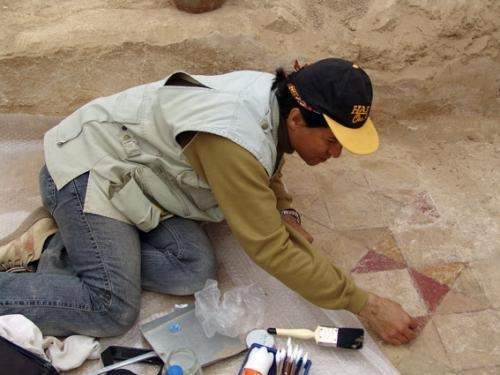
A designed floor belonging to the early Sassanid era was discovered for the first time in the city of Gour.
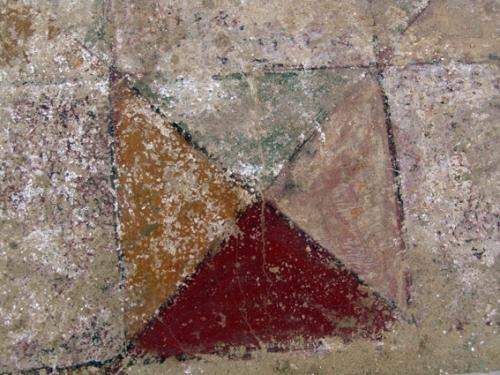
The
colors used in this floor have been remained intact which indicate the
special attention to use various colors in architecture during the
Sassanid era.
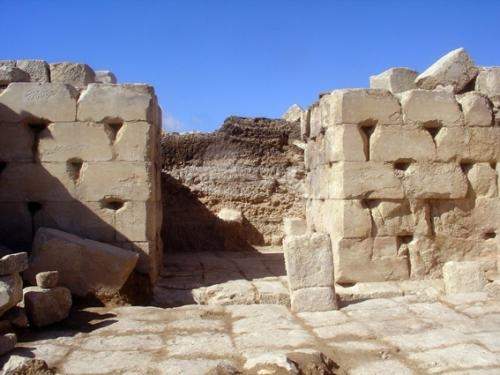
One
of the other important archeological achievements in city of Gour was
the discovery of seat area gate which is very similar to the Persepolis
facades.
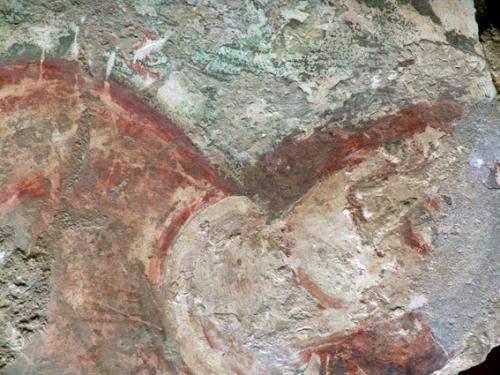
The design of one of Sassanid princes was discovered in the city of Gour.
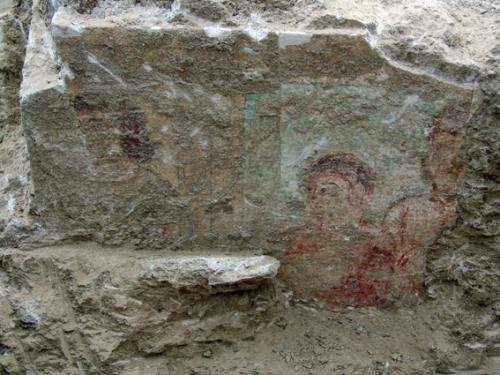
The murals of four Sassanid princes have been discovered for the first time on one of the walls of the palace.
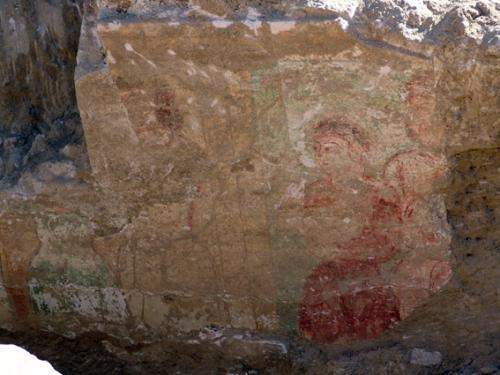
These
four princes were consisted of two women, and two young men. The method
used in this fresco shows the effect of the Parthian painting on the
art of the bigging of the Sassanid era.
|
-------------
|
|










